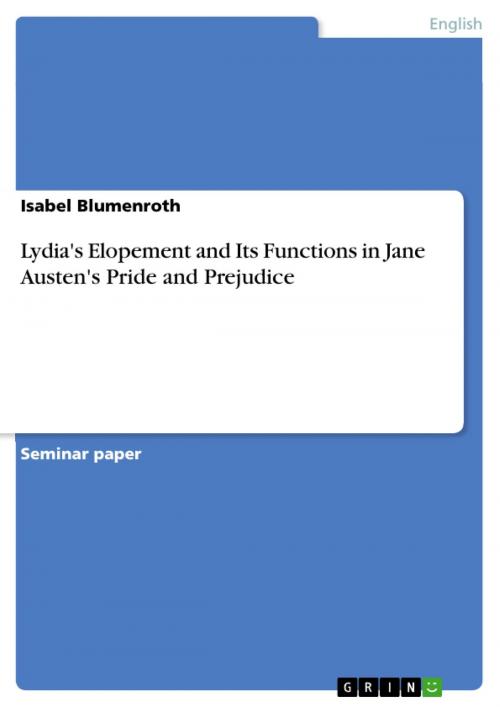Lydia's Elopement and Its Functions in Jane Austen's Pride and Prejudice
Fiction & Literature, Literary Theory & Criticism, British| Author: | Isabel Blumenroth | ISBN: | 9783638539333 |
| Publisher: | GRIN Publishing | Publication: | August 29, 2006 |
| Imprint: | GRIN Publishing | Language: | English |
| Author: | Isabel Blumenroth |
| ISBN: | 9783638539333 |
| Publisher: | GRIN Publishing |
| Publication: | August 29, 2006 |
| Imprint: | GRIN Publishing |
| Language: | English |
Seminar paper from the year 2003 in the subject English Language and Literature Studies - Literature, grade: 1,3, RWTH Aachen University, course: 19th Century Women Novelists: Jane Austen, Charlotte and Emily Bronte, 20 entries in the bibliography, language: English, abstract: Introduction Even today, nearly 200 years after her death, Jane Austen is still one of the best-known writers of English Literature. Her novel of manners bridged the neo-classical period in which she grew up with the gradual oncoming of the Romantic period 1 with its interest in the individual's growth within the boundaries of its environment. Still conservative in her values and morals, she was nevertheless an advanced writer as far as her way of writing is concerned. Disliking the sentimental novel of her time, she managed to provide an accurate and truthful social portrait. On the other hand she reconciled this ironic view with the credible presentation of a man and woman undergoing a serious 'change of sentiments' 2 . In this new entertaining genre Austen thus developed a power of character-drawing 3 especially prominent in her dynamic main figures. Pride and Prejudice (published in 1813) 4 , one of her best-known novels, is not exceptional in this respect. Its main figures Elizabeth Bennet and Fitzwilliam Darcy prove to be a dynamic pair of figures undergoing a profound change of attitudes and opinions. A lot of analytic secondary literature has been written about those two characters and the development of their relationship. Unfortunately, the bulk of subsidiary characters of the book has not enjoyed that much popularity with the critics. Some of those subsidiary characters belong to the class of comic characters and indeed impact on the development of the novel's structure and plot on the discourse level which should not be underestimated. Consequently, this paper will analyse one crucial subplot in Pride and Prejudice which is inseparably connected to the subsidiary figure of Lydia. Although mainly serving as a means of irony in the course of the novel's first part, Lydia Bennet and her actions only gain importance in the last third of the book when she chooses to do the one thing her elder sister Elizabeth has always been afraid of and elopes with the officer George Wickham, risking her own reputation as well as that of her family. It will be the purpose of this paper to analyse this episode in detail which will be done by having a closer look at the following three aspects: [...]
Seminar paper from the year 2003 in the subject English Language and Literature Studies - Literature, grade: 1,3, RWTH Aachen University, course: 19th Century Women Novelists: Jane Austen, Charlotte and Emily Bronte, 20 entries in the bibliography, language: English, abstract: Introduction Even today, nearly 200 years after her death, Jane Austen is still one of the best-known writers of English Literature. Her novel of manners bridged the neo-classical period in which she grew up with the gradual oncoming of the Romantic period 1 with its interest in the individual's growth within the boundaries of its environment. Still conservative in her values and morals, she was nevertheless an advanced writer as far as her way of writing is concerned. Disliking the sentimental novel of her time, she managed to provide an accurate and truthful social portrait. On the other hand she reconciled this ironic view with the credible presentation of a man and woman undergoing a serious 'change of sentiments' 2 . In this new entertaining genre Austen thus developed a power of character-drawing 3 especially prominent in her dynamic main figures. Pride and Prejudice (published in 1813) 4 , one of her best-known novels, is not exceptional in this respect. Its main figures Elizabeth Bennet and Fitzwilliam Darcy prove to be a dynamic pair of figures undergoing a profound change of attitudes and opinions. A lot of analytic secondary literature has been written about those two characters and the development of their relationship. Unfortunately, the bulk of subsidiary characters of the book has not enjoyed that much popularity with the critics. Some of those subsidiary characters belong to the class of comic characters and indeed impact on the development of the novel's structure and plot on the discourse level which should not be underestimated. Consequently, this paper will analyse one crucial subplot in Pride and Prejudice which is inseparably connected to the subsidiary figure of Lydia. Although mainly serving as a means of irony in the course of the novel's first part, Lydia Bennet and her actions only gain importance in the last third of the book when she chooses to do the one thing her elder sister Elizabeth has always been afraid of and elopes with the officer George Wickham, risking her own reputation as well as that of her family. It will be the purpose of this paper to analyse this episode in detail which will be done by having a closer look at the following three aspects: [...]















